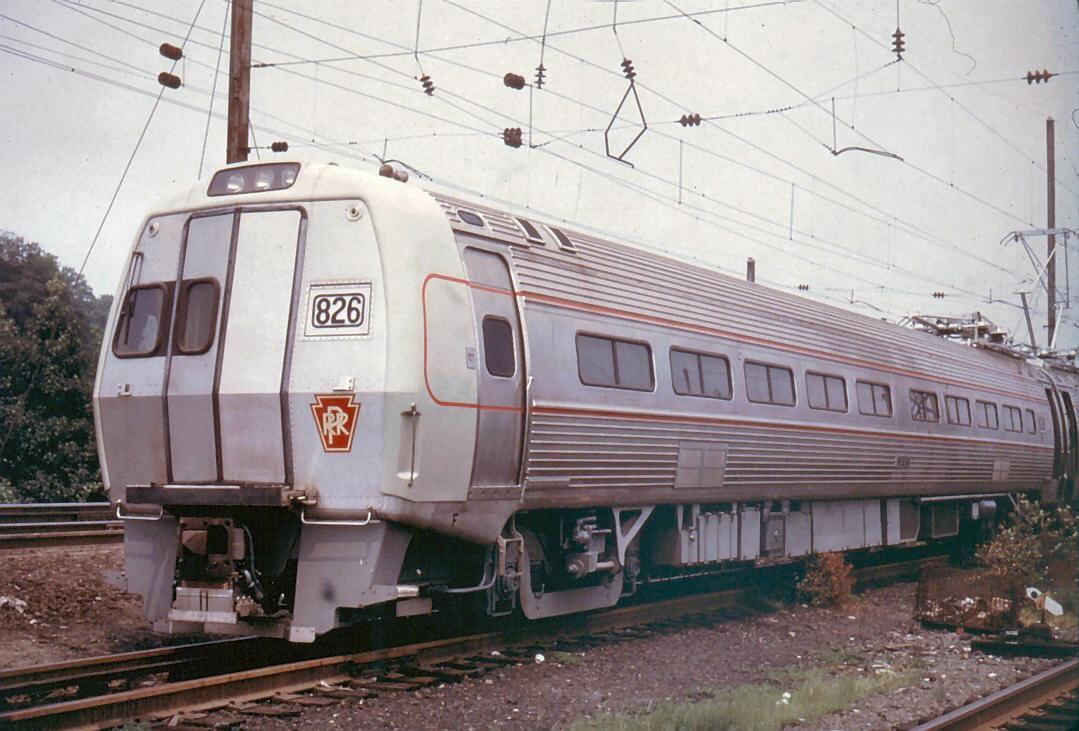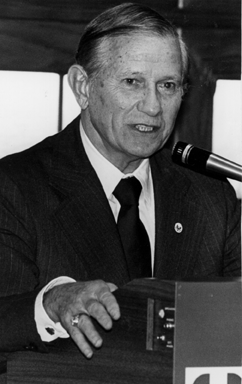1970-1972: The first years
John Volpe, the chief architect of Amtrak
With signiciant input by the National Association of Railroad Passengers, the Rail Passenger Service Act was a complicated piece of legislation. It was the brainchild of a John Volpe, the Secretary of Transportation for the US Federal Government. It was his sheer determination that pushed the Act through Congress, and his personal appeals to President Richard Nixon. Nixon was a hard nut to crack, but eventually wilted to Volpe's influence, in part due to Nixon's new environmentally friendly position. How could a President aiming to have a comprehensive environmental policy effectively advocate everyone driving everywhere? After this, Volpe, together with Senator Vance Hartke worked on the Act, eventually presenting it to the Senate Commerce Commission.
The legislation created a new government-backed company, "Railpax" (although later in the year this would be renamed "Amtrak"), which would take over rail passenger operations. Railroads would be invited to "transfer" their passenger operations, effectively allowing them to close down passenger operations and let Amtrak run them instead, in return for either cash or rolling stock. It also set Railpax up with a fund which with to purchase suitable railroad routes. This part had been somewhat controversial, but had been included nonetheless as it was essential for the last demand upon the new Railpax - to innovate and passenger rail profitable again.
Most railroad companies agreed to cede their passenger operations to Railpax; only a few decided to continue operating passenger trains themselves, with the majority granting rolling stock and some cash as keeping passenger-oriented rolling stock made little sense after closing their passenger operations. Long-distance Intercity routes were granted to Amtrak, along with several commuter rail operations - primarily those centred upon Chicago, Boston, New York, Philadelphia & Washington DC cities. Initially the commuter rail operations had been intended to be granted to state-run corporations, but successful lobbying meant that Amtrak took them over, mostly to benefit from economies of scale and a single management vision.
Soon after, arguments started on how to turn around (the by now named) Amtrak. Did it's future lie with gold-service long distance trains, trying to win over passengers by travelling in style? It would quickly be determined not; Amtrak's road to recovery would apparently lie with trying to take on the airlines and cars on short to mid range distances - the kind of destinations you could reach in approximately 3-4 hours, with passengers transported in fast, clean, modern & reliable trains. The fact that Amtrak could arrive and depart from the very city centres of it's destinations gave Amtrak a distinct selling point over the airlines.
This quickly left Amtrak with both a vision to pursue; now all it needed was the routes upon which to run the trains. Prior to Railpax, passenger trains had been run on the same tracks as freight trains, and were frequently delayed or cancelled as a result of freight operations. This would be unacceptable for Amtrak's vision; at least on their core routes. Further out from a core, compromises could be made which involved running their trains on freight tracks. The initial focus areas were obvious from a number of perspectives; the North East Corridor, serving the large cities of Boston, New York, Newark, Philadelphia, Baltimore and Washington DC. This route was already highly rated, with a good passenger service on, and also acted as the core for most of the commuter rail operations. The other area that would be focussed on was the Mid West - centred on Chicago. The area also had several large cities in close enough proximity to be competitive, as well as a huge number of railroads in every direction, and it was obvious that a pruning of the railroad network was going to be needed if freight railroads were going to break even again. Geography also helped - the flat land meant that railroads had less need to curve around obstacles or have steep gradients, which aided high speed operations.
Most importantly though, both areas were primarily owned by a couple of railroads who were both desperate for cash to address their own pressing financial states. Penn Central, desperately trying to hold up the weight of three railroads incorporated into itself and the Milwaukee Road, struggling to meet the costs of it's expensive Pacific Extension. The Milwaukee Road had attempted to buy out the Chicago & North Western Railroad in a few years prior, only to be refused permission by the Interstate Commerce Commission. Now the tables had turned - the C&NW was interested (now that the ICC were not as powerful as before, and the perilous state of railroad finances made approvals more likely), but the Milwaukee Road was looking for bigger partners to merge with. At the urging of Amtrak - something controversial, considering a government-run company meddling in the private-sector, the Milwaukee Road decided to merge with the C&NW. Amtrak agreed to purchase in cash sections of railroad from Chicago to Minneapolis (via Milwaukee) which would become somewhat over-served by the merged corporation's railroads (which would come to be known as the "Chicago, Milwaukee & North Western Railroad").
The North East Corridor was a quick and easy purchase for Amtrak from Penn Central, which included the whole of the route from Washington DC to Boston, including the branch from New Haven to Springfield. In the Mid West, further purchases from the financially crippled Penn Central were railroads from Chicago to Indianapolis (and on to Cincinnati & Louisville) as well as Chicago to Fort Wayne (and on to Detroit and Cleveland). All these purchases were vitally important in setting the ground for what was to come, but did eat away at almost all of Amtrak's grants from the federal Government. Also arriving fresh out of the builder's yards were the new UAC TurboTrains. These were gas-turbine trains, and high speed ones at that. They started serving the Boston - New York route almost immediately, giving passengers a lot more comfortable a trip, as that section was still unelectrified. Ex-Pennsylvania Railroad Metroliner trains ran on the Washington DC - New York section, taking advantage of the electrified lines.

Metroliner train, still in PRR livery, on the North East Corridor
------------------------------
Notes: As ever, my little notes section makes a return. Few key differences here; 1) Amtrak is able to pursue a high speed rail vision for the US from the outset. Not trying to make the best of all the existing trains, and is more free to innovate. 2) Amtrak is able to take over railroads from it's inception onwards, which is closely linked to....3) Amtrak is running commuter railroads. This means that there is no conflict over priorities and vision (cough....North East Corridor between New Rochelle and New Haven....cough cough), and Amtrak is thus free to upgrade lines where ever it sees fit in later years.
One large butterfly already.....Milwaukee Road and Chicago & North Western have merged. I'm sure some little accountant for the C&NW going over the Milwaukee Road accounts will notice that expenses for their Pacific Extension have been double entered, and thus it's actually very profitable. The Chicago, Milwaukee & North Western could well be around for a while yet.....
PS: Feedback, comments, corrections are always welcome.


